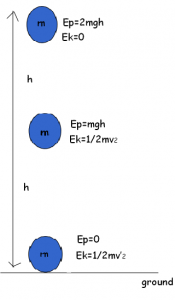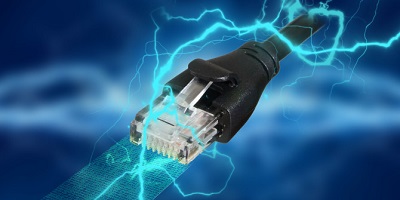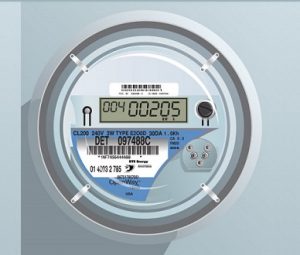Law of conservation of energy:
- According to law of conservation of energy, “energy can neither be created nor be destroyed but can be transformed from one form to another”.
- The total energy before and after the transformation remains the same.
- Although a little amount of energy wasted during the conversion but overall energy of the system remains conserved.
Conservation of energy of a free fall body:
- A ball of mass m at some height h has a potential energy of mgh.
- As it starts falling its potential energy decreases.
- Kinetic energy at height h is ‘0’ but starts increasing during downfall.
- The mechanical energy (i.e. sum of kinetic and potential energy) remains conserved at each point during its fall.
\(\frac{1}{2}\)mv2 + mgh = constant
- Kinetic Energy + Potential Energy = Constant

Power:
- The rate of doing work is said to be power.
- Simply, we can say that power is the rate of energy consumption.
- The SI unit of power is watt or Joule/Sec.
- 1-watt power may be defined as the power of device which consumes energy of 1 joule in 1 sec.
- Power = \(\frac{Work\:done}{Time\:taken}\) = \(\frac{W}{t}\)
- Average power = \(\frac{total\:work\:done}{total\:time\:taken}\)

Power of an appliance:
- The power of an appliance tells us its rate of consumption of energy.
- We measure power in Kilo Watt at larger scale.
1 Kilowatt (KW) = 1000 Watt (W or J/s)
Commercial unit of energy:
- In everyday life we use much electricity per day in several means. It is inconvenient to measure the consumption in joule as it is much small amount.
- For commercial purpose we measure electricity consumption in Kilowatt hour (KWh).
- 1 KWh is the amount of energy consumed when an appliance having a rating of power 1 Kilowatt and is used for 1 hour.

Relation between kilowatt hour and Joule/ Mathematical relation between KWh and joule:
- 1 Kilowatt hour (KWh) = 1kilowatt x 1 hour
1 KWh = 1000W x 3600 sec = 3600000 Joules
1 KWh = 3.6 x 106 Joules = 1unit
Work and Energy Class 9 Examples:
Q. What will cause greater change in kinetic energy of a body? Changing its mass or changing its velocity?
Solution:
As K.E = \(\frac{1}{2}\) mv2 therefore,
K.E ∝ m
K.E ∝ v2
Hence, the change in the velocity of a body will cause a greater change in kinetic energy.
Q. A horse of mass 210 kg and a dog of mass 50 kg are running at the same speed. Which of the two possesses more kinetic energy? How?
Solution:
Kinetic energy, K.E. = 1/ 2 mv2
At constant velocity, Kinetic energy is directly proportional to mass. Hence, as mass increases, kinetic energy also increases. In this case, the mass of a horse is greater than that of dog, so the kinetic energy of the horse is greater than the dog when it is given that speed is constant.
Q. If our heart works 60 joules in one minute, find its power?
Solution:
The power of heart is given by,
Power = work done/time = 60 j / 60 s = 1W. [As Watt (W) = J/s]
Hence power of heart = 1 Watt
When a ball is thrown vertically upwards, its velocity goes on decreasing. What happens to its potential energy as its velocity becomes zero?
Solution:
According to the law of conservation of energy, energy can neither be created nor be destroyed but can be transformed from one form to another.
Therefore, Kinetic energy lost by the ball = Potential Energy gained by the ball
So, as the velocity of the ball becomes zero then K.E would be zero and the P.E. would be maximum.